Call Center KPIs and Why They Matter Today
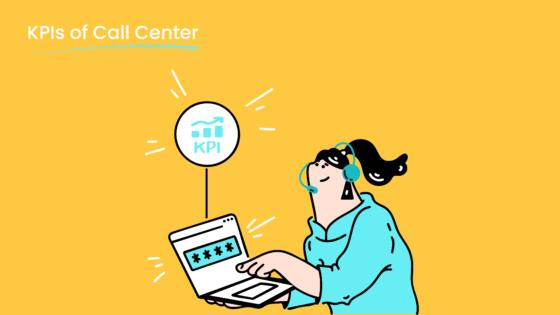
Call center KPIs are measurable metrics that assess the performance and efficiency of call center operations. These indicators play a vital role in enhancing customer satisfaction, improving agent productivity, and streamlining operational processes. For instance, achieving an 80% or higher First Call Resolution (FCR) rate significantly boosts customer trust and reduces repeated inquiries. Similarly, maintaining a Customer Satisfaction Score (CSAT) of 85% or more reflects positive customer experiences.
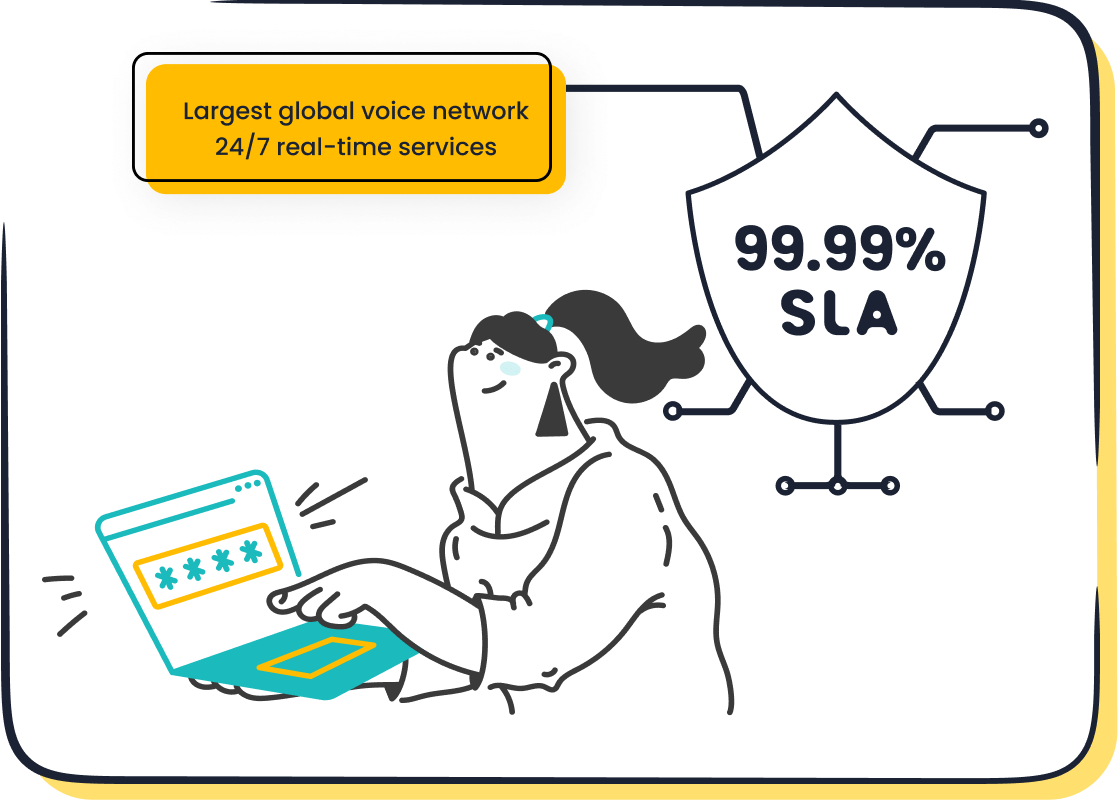
You need tools that provide real-time monitoring and actionable performance insights to optimize these metrics. Sobot’s Voice/Call Center solutions offer intelligent features like call tracking, AI-powered analytics, and unified workspaces. These tools empower you to monitor essential KPIs effectively, ensuring better outcomes for your call center operations.
Why Call Center KPIs Are Crucial
Enhancing Customer Experience
Call center KPIs play a pivotal role in shaping the customer experience. Metrics like First Call Resolution (FCR) and Customer Satisfaction Score (CSAT) directly reflect how well your call center meets customer needs. For example, resolving issues on the first call not only saves time but also builds trust. A high CSAT indicates that customers leave interactions feeling valued and satisfied.
Tracking these KPIs allows you to identify pain points in customer interactions. For instance, a high Call Abandonment Rate might signal long wait times, which frustrates customers. By addressing this, you can improve service responsiveness and ensure customers feel heard. Companies like Delta Air Lines have demonstrated this impact. By focusing on Net Promoter Score (NPS) and CSAT, they achieved a 15% increase in customer satisfaction, which contributed to a 7% rise in annual revenue.
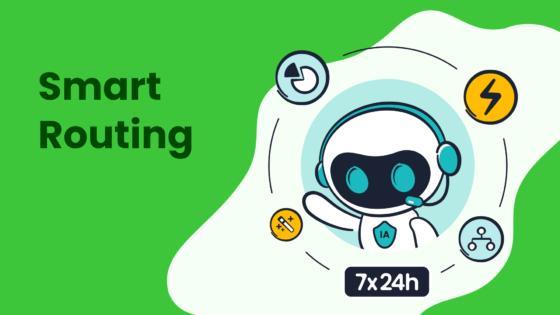
Sobot’s Voice/Call Center solutions make it easier to monitor these metrics in real time. Features like call tracking and AI-powered analytics help you understand customer behavior and optimize service delivery. This ensures that every interaction contributes to a positive customer experience.
Driving Agent Productivity
Call center KPIs also serve as a compass for agent performance. Metrics such as Average Handle Time (AHT) and Occupancy Rate reveal how efficiently agents manage their workload. Lowering AHT, for example, enables agents to handle more calls without compromising quality, boosting overall productivity.
When you track KPIs like After-Interaction Work and First Contact Resolution, you gain insights into how agents spend their time. This helps you identify areas for improvement, such as reducing time spent on repetitive tasks. Effective KPI tracking also highlights top-performing agents, allowing you to replicate their strategies across the team.

Sobot’s unified workspace simplifies this process by consolidating customer data and call information in one place. Agents can access everything they need without switching systems, saving time and reducing errors. This streamlined approach not only enhances productivity but also improves customer satisfaction ratings.
Improving Operational Efficiency
Operational efficiency is the backbone of successful call center operations. KPIs like Service Level and Cost per Call (CPC) provide a clear picture of how well your resources are utilized. For instance, maintaining a high Service Level ensures that most calls are answered promptly, reducing customer frustration.
By analyzing metrics such as Average Queue Time and Call Abandonment Rate, you can pinpoint inefficiencies in your processes. Addressing these issues helps lower operational costs while improving service quality. Companies like CVS Health have shown how effective KPI tracking can lead to a 20% improvement in customer experience metrics and a 10% increase in customer retention.
Sobot’s Voice/Call Center solutions offer tools like intelligent IVR and smart call routing to optimize workflows. These features ensure that calls are directed to the right agents quickly, minimizing wait times and enhancing efficiency. With a 99.99% system uptime, Sobot provides the reliability you need to maintain seamless operations.
Supporting Strategic Decision-Making with Data
Call center KPIs provide more than just operational insights. They serve as a foundation for strategic decision-making, enabling you to align your call center's performance with broader business goals. By analyzing these metrics, you can identify trends, predict outcomes, and make data-driven decisions that improve both short-term efficiency and long-term growth.
How KPI Dashboards Drive Strategic Insights
KPI dashboards consolidate critical metrics into a single, easy-to-read interface. These dashboards help you track performance across various dimensions, such as customer satisfaction, agent productivity, and operational efficiency. For example, a Customer Service Dashboard might display metrics like First Response Time, Resolution Time, and Customer Satisfaction Score. These insights allow you to pinpoint areas needing improvement and allocate resources effectively.
| Dashboard Type | Key Metrics Tracked |
|---|---|
| Revenue Dashboard | Total revenue, revenue growth, average revenue per customer, churn rate, etc. |
| Sales Dashboard | Sales volume, sales revenue, sales growth, sales conversion rate, etc. |
| Marketing Dashboard | Website traffic, conversion rate, cost per acquisition, social media metrics, etc. |
| Financial Dashboard | Revenue, expenses, net income, cash flow, financial ratios, etc. |
| Operations Dashboard | Production rates, inventory levels, order fulfillment times, etc. |
| Human Resources Dashboard | Headcount, turnover rate, employee satisfaction, training effectiveness, etc. |
| Customer Service Dashboard | First response time, resolution time, customer satisfaction score, ticket volume, etc. |
| Project Management Dashboard | Project timeline, budget, tasks completed, resource allocation, etc. |
| IT Dashboard | System uptime, security incidents, technology infrastructure performance, etc. |
These dashboards also provide comparative references, such as performance against benchmarks, and trend indicators that reveal directional movement. For instance, if your First Call Resolution rate shows a downward trend, you can investigate the root cause and implement corrective measures.
Leveraging Sobot’s Tools for Smarter Decisions
Sobot’s Voice/Call Center solutions simplify the process of gathering and analyzing KPI data. With features like real-time monitoring and AI-powered analytics, you can visualize relationships between metrics and drill down from summaries to detailed insights. For example, Sobot’s intelligent IVR and smart call routing not only improve operational efficiency but also generate actionable data for strategic planning.
Imagine using Sobot’s unified workspace to track agent productivity metrics like Average Handle Time and Occupancy Rate. These insights can guide decisions on staffing, training, and workflow optimization. Additionally, Sobot’s 99.99% system uptime ensures uninterrupted access to your KPI dashboards, so you can make timely decisions without delays.
Why Data-Driven Decisions Matter
Data-driven decisions reduce guesswork and increase the likelihood of achieving your business objectives. By understanding how metrics influence each other, you can prioritize initiatives that deliver the highest impact. For example:
- Improving Service Level can reduce Call Abandonment Rates, leading to higher customer satisfaction.
- Optimizing Average Queue Time can enhance agent productivity and lower operational costs.
Sobot’s solutions empower you to act on these insights with confidence. Whether you aim to improve customer retention or streamline operations, the right data ensures your strategies are both effective and measurable.
Tip: Use trend indicators and hierarchical views in your dashboards to uncover hidden opportunities and risks. This approach helps you stay proactive rather than reactive in your decision-making.
By integrating call center KPIs into your strategic planning, you can transform your call center from a cost center into a value-driving asset. With tools like Sobot’s Voice/Call Center, you gain the clarity and control needed to make decisions that propel your business forward.
Key Call Center KPIs to Track
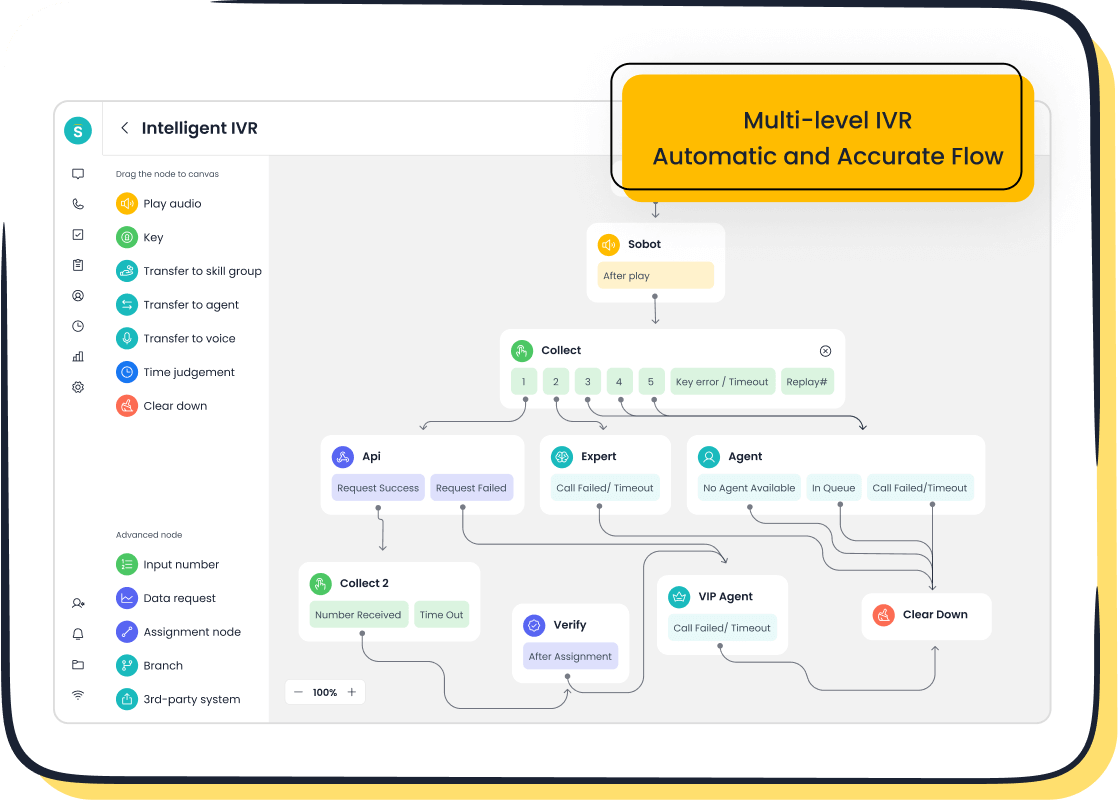
Tracking the right call center KPIs ensures your call center operations run smoothly and meet customer expectations. Below are the key categories of metrics you should monitor to improve customer satisfaction, agent performance, and overall efficiency.
Customer Experience Metrics (e.g., CSAT, NPS, FCR)
Customer experience metrics measure how well your call center meets customer needs. These metrics provide insights into satisfaction, loyalty, and ease of interaction.
- Customer Satisfaction (CSAT): This metric evaluates how satisfied customers feel after interacting with your call center. It’s calculated by dividing the number of satisfied responses by the total responses and multiplying by 100. For example, maintaining a CSAT score above 85% indicates a high level of satisfaction.
- Net Promoter Score (NPS): NPS measures customer loyalty by asking how likely customers are to recommend your service. A higher NPS reflects stronger loyalty and satisfaction.
- First Call Resolution (FCR): FCR tracks the percentage of issues resolved during the first interaction. Achieving an FCR rate of 80% or higher reduces repeat calls and builds trust.
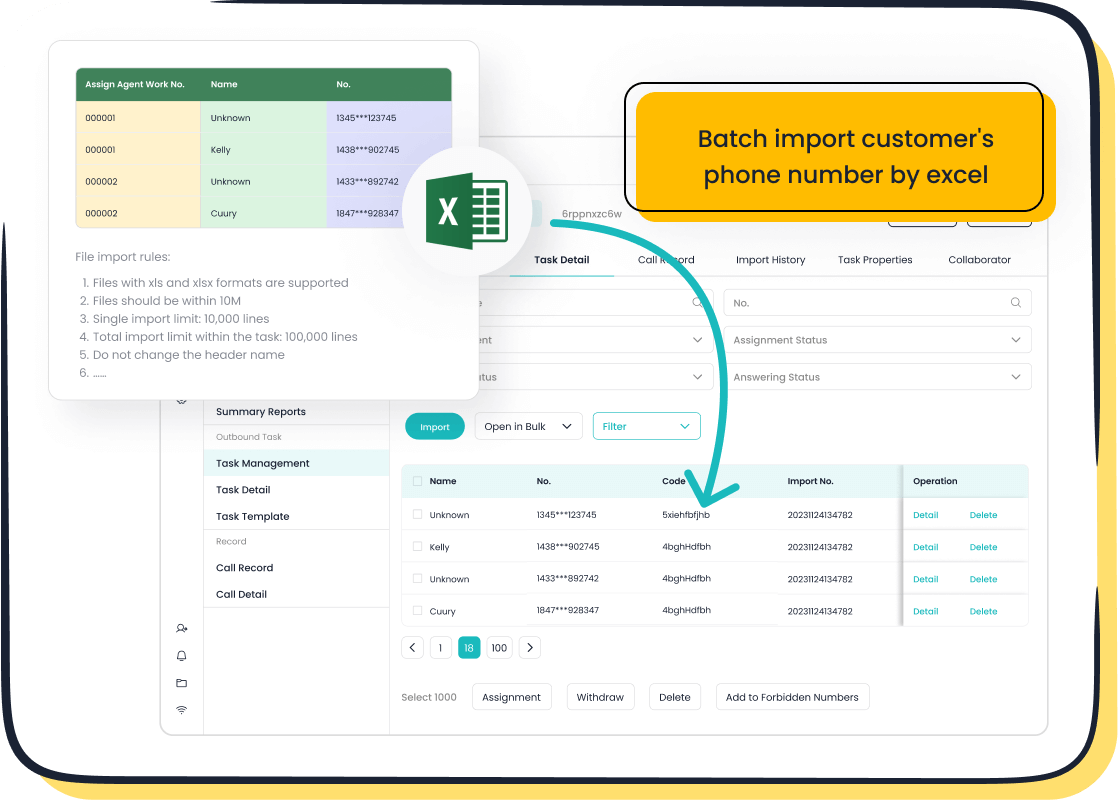
Tip: Use tools like Sobot’s Voice/Call Center to monitor these metrics in real time. Features like call tracking and AI-powered analytics help you identify areas for improvement and enhance the customer experience.
| KPI Name | Description |
|---|---|
| Net Promoter Score (NPS) | Measures customer loyalty based on their likelihood to recommend the company. |
| Customer Satisfaction (CSAT) | Assesses customer satisfaction with specific interactions through surveys. |
| First Call Resolution (FCR) | Indicates the percentage of issues resolved on the first contact, reflecting efficiency. |
| Customer Effort Score (CES) | Evaluates how easy it is for customers to interact with the company. |
Analyzing these customer experience metrics helps you pinpoint pain points and take actionable steps to improve service quality. For instance, a lower NPS might indicate dissatisfaction at certain touchpoints, allowing you to address these issues promptly.
Agent Productivity Metrics (e.g., Average Handling Time, Occupancy Rate)
Agent productivity metrics reveal how efficiently your team handles customer interactions. These metrics help you optimize workforce performance and identify training needs.
- Average Handle Time (AHT): AHT measures the average duration of customer interactions, including talk time and after-call work. Lower AHT indicates quicker resolutions, but it’s essential to balance speed with quality.
- Occupancy Rate: This metric shows the percentage of time agents spend actively engaged in work-related tasks. A higher occupancy rate reflects better utilization of agent time.
- Agent Utilization Rate: This measures how effectively agents use their time, helping you identify opportunities for process optimization.
| Benefit | Description |
|---|---|
| Operational efficiency and cost control | AHT helps identify areas for process optimization, leading to quicker customer interactions and cost savings. |
| Planning and forecasting | Understanding AHT aids in resource allocation and workforce management. |
| Agent performance management | AHT provides insights into individual agent efficiency, guiding training and performance improvement. |

Sobot’s unified workspace simplifies tracking these metrics by consolidating customer data and call information in one place. This allows agents to focus on resolving issues efficiently without switching between systems.
Example: If your AHT is too high, it may indicate inefficiencies in workflows. Sobot’s AI-powered Voicebot can automate repetitive tasks, reducing AHT while maintaining service quality.
Operational Performance Metrics (e.g., Service Level, Call Abandonment Rate)
Operational performance metrics measure the efficiency of your call center processes. These metrics ensure you meet service commitments and maintain customer satisfaction.
- Service Level: This KPI defines the percentage of calls answered within a predetermined time frame. A high service level ensures prompt responses, reducing customer frustration.
- Call Abandonment Rate: This metric tracks the percentage of callers who hang up before connecting with an agent. High abandonment rates often signal long wait times or inadequate staffing.
- Average Speed of Answer (ASA): ASA measures the average time customers wait before speaking to an agent. Reducing ASA improves the overall customer experience.
Note: High call abandonment rates can cost businesses significantly. A survey by American Express found that each abandoned call could cost up to $50. Reducing queue times to under two minutes can lower abandonment rates and increase revenue.

Strategies like smart call routing and intelligent IVR, available in Sobot’s Voice/Call Center, help optimize these metrics. For example, Sobot’s system ensures calls are directed to the right agents quickly, minimizing wait times and improving service levels.
Tip: Regularly review these metrics to identify bottlenecks in your processes. Addressing inefficiencies can lead to higher customer retention and lower operational costs.
Quality Assurance Metrics (e.g., Call Monitoring Scores, Compliance Rates)
Quality assurance metrics ensure your call center delivers consistent, high-quality service. These metrics evaluate agent performance, compliance with company policies, and adherence to industry regulations. By tracking metrics like Call Monitoring Scores and Compliance Rates, you can identify areas for improvement, reduce risks, and enhance customer satisfaction.
Key Metrics for Quality Assurance
| Metric | Description | Calculation Formula |
|---|---|---|
| First Call Resolution (FCR) | Percentage of customer issues resolved on the first interaction without follow-ups. | FCR = (Total Calls Resolved on First Contact / Total Calls Handled) x 100 |
| Average Handle Time (AHT) | Total time an agent spends on a customer interaction, reflecting efficiency. | AHT = (Total Talk Time + Total Hold Time + Total After-Call Work Time / Total Calls Handled) |
| Customer Satisfaction (CSAT) | Measures customer satisfaction with service interactions, typically through post-call surveys. | CSAT = (Total Satisfied Responses (4 or 5 stars) / Total Survey Responses) x 100 |
These metrics provide a clear picture of how well your call center meets customer expectations. For example, a high FCR rate indicates efficient issue resolution, while a strong CSAT score reflects positive customer experiences.
Why Quality Assurance Metrics Matter
- Improved Customer Satisfaction: High-quality service builds trust and loyalty. Customers who feel valued are more likely to return and recommend your business.
- Increased First Call Resolution: Resolving issues on the first call reduces repeat inquiries. Studies show that 90% of customer dissatisfaction stems from unresolved issues during the first interaction.
- Compliance and Risk Management: Monitoring compliance rates minimizes regulatory risks. Effective quality assurance practices can reduce the likelihood of penalties by 30%.
Tip: Regularly review Call Monitoring Scores to ensure agents follow scripts, maintain professionalism, and adhere to compliance standards.
How Sobot Enhances Quality Assurance
Sobot’s Voice/Call Center solutions simplify quality assurance with advanced tools like real-time call monitoring and AI-powered analytics. These features allow you to evaluate agent performance, identify training needs, and ensure compliance with industry standards. For example, Sobot’s intelligent IVR system records and analyzes calls, providing actionable insights to improve service quality.
With Sobot, you can track call center KPIs like FCR, AHT, and CSAT in a unified workspace. This centralized approach ensures you have all the data you need to make informed decisions. Additionally, Sobot’s 99.99% system uptime guarantees uninterrupted access to these insights, enabling you to maintain high-quality service at all times.
Example: A retail company using Sobot’s solutions improved its compliance rate by 25% within six months. This success resulted from consistent monitoring and targeted agent training based on KPI insights.
By focusing on quality assurance metrics, you can transform your call center into a hub of excellence. Tools like Sobot’s Voice/Call Center empower you to deliver exceptional service, ensuring every customer interaction leaves a lasting positive impression.
How to Use Call Center KPIs Effectively
Setting Clear Goals and Benchmarks
Clear goals and benchmarks are essential for improving call center performance. Start by identifying the call center metrics that align with your business objectives. For example, tracking Net Promoter Score (NPS) helps you measure customer loyalty, while First Call Resolution (FCR) reflects how efficiently your team resolves issues. Companies that focus on enhancing customer service often see a 42% improvement in customer retention and a 33% increase in customer satisfaction.
To set effective benchmarks, prioritize metrics that drive actionable insights. For instance, monitoring Average Handle Time (AHT) can reveal inefficiencies in workflows, while Service Level ensures calls are answered promptly. Regularly review these benchmarks to adapt to changing customer needs and market conditions. Metrics also foster accountability, encouraging teams to take ownership of their performance.
Sobot’s Voice/Call Center solutions simplify this process. Features like intelligent IVR and real-time analytics provide the data you need to set realistic goals and track progress. By leveraging these tools, you can align your call center operations with broader business objectives and achieve measurable success.
Leveraging Sobot's Voice/Call Center for Real-Time Monitoring
Real-time monitoring is crucial for maintaining high call center performance. Implementing a KPI dashboard allows you to track metrics like Call Abandonment Rate and Customer Satisfaction Score (CSAT) as they happen. This helps you identify issues early and take corrective action before they escalate.
Sobot’s Voice/Call Center solutions offer advanced monitoring tools that integrate seamlessly into your daily operations. For example, the unified workspace consolidates call data, enabling you to analyze trends and relationships between metrics. Intelligent IVR and smart call routing ensure calls are handled efficiently, reducing Average Queue Time and improving Service Level.
To implement real-time monitoring effectively, follow these steps:
- Start with core metrics aligned to your business goals.
- Gradually introduce measurement systems to minimize resistance.
- Ensure data quality and consistency across all channels.
- Provide context by showing how metrics relate to each other.
- Regularly review and adjust targets based on feedback.
By using Sobot’s tools, you gain actionable insights that enhance customer service and optimize call center operations.
Providing Feedback and Training Based on KPI Insights
Feedback and training based on KPI insights improve agent performance and customer satisfaction. Metrics like CSAT, FCR, and AHT highlight areas where agents excel and where they need support. For example, if AHT is too high, training can focus on streamlining workflows to resolve issues faster.
Sobot’s Voice/Call Center solutions make this process easier. Real-time call monitoring and AI-powered analytics provide detailed insights into agent performance. Use these insights to create personalized training programs that address specific challenges. For instance, agents struggling with FCR can receive targeted coaching to improve issue resolution on the first call.
Companies that invest in training based on KPI insights often see significant improvements. A retail company using Sobot’s solutions increased its compliance rate by 25% within six months. This success resulted from consistent monitoring and tailored training programs.
Tip: Regularly review KPI data to identify trends and adjust training programs accordingly. This ensures agents stay equipped to meet evolving customer expectations.
Using AI and Automation to Optimize Performance
AI and automation have revolutionized how you can manage call center KPIs, making operations more efficient and customer interactions more seamless. These technologies handle repetitive tasks, analyze data, and predict trends, allowing you to focus on strategic improvements.
How AI Enhances Call Center Operations
AI-driven tools bring precision and speed to call center processes. They predict call volumes and staffing needs with remarkable accuracy, ensuring you always have the right resources in place. This capability, known as AI-Driven Call Forecasting, improves customer satisfaction by reducing wait times and ensuring timely responses. Additionally, AI automates data analysis, enabling you to evaluate metrics like call duration, agent performance, and customer interactions effortlessly.
- AI enhances call routing by analyzing customer data to connect them with the most suitable agents.
- It reduces the need for staff to handle routine inquiries, freeing up resources for complex tasks.
- AI integration allows for 24/7 customer support, meeting the demands of global customers across different time zones.
A study by Zendesk found that 69% of consumers prefer chatbots for quick answers, highlighting AI's effectiveness in streamlining interactions. This preference underscores the importance of integrating AI into your call center strategy.
Automation’s Role in Optimizing KPIs
Automation complements AI by handling repetitive tasks like ticket creation, follow-ups, and data entry. This reduces Average Handle Time (AHT) and improves First Call Resolution (FCR), two critical call center KPIs. For example, Sobot’s AI-powered Voicebot can automate routine customer interactions, ensuring faster resolutions without compromising quality.
Tip: Use automation to monitor real-time metrics like Call Abandonment Rate and Service Level. This helps you identify and address inefficiencies immediately.
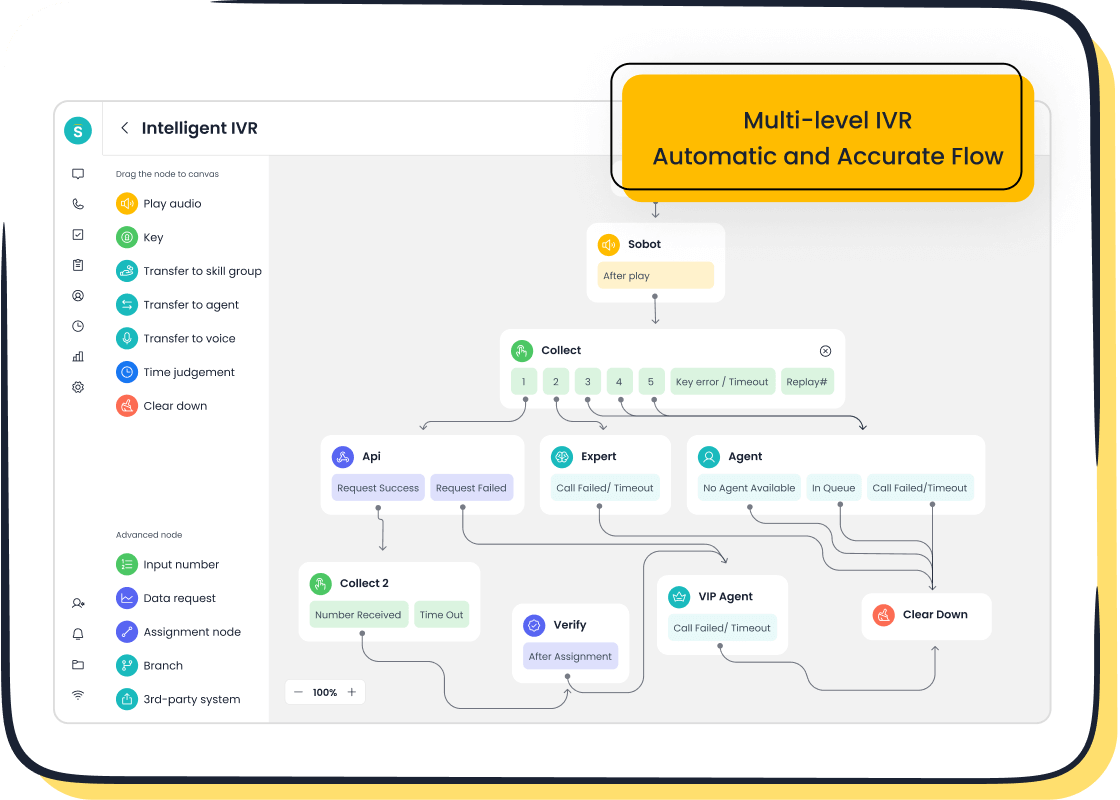
By leveraging AI and automation, you can transform your call center into a high-performing, customer-centric operation. Sobot’s Voice/Call Center solutions provide the tools you need to achieve this, offering features like intelligent IVR, smart call routing, and AI-powered analytics. These capabilities ensure your call center not only meets but exceeds performance benchmarks.
Choosing the Right KPIs for Your Call Center
Aligning KPIs with Business Objectives
Your call center KPIs should reflect your company’s broader goals. For example, if your business focuses on customer retention, metrics like Net Promoter Score (NPS) and First Call Resolution (FCR) become essential. These KPIs measure customer loyalty and issue resolution efficiency, directly impacting retention rates.
A leading insurance company demonstrated this alignment effectively. By focusing on KPIs tied to sales conversions, they improved their conversion rate by 40%. They achieved this by implementing skill-based routing and enhanced training programs. This approach not only boosted efficiency but also elevated customer satisfaction.
To help you align KPIs with your goals, here’s a quick reference table:
| KPI | Definition | Related Industries |
|---|---|---|
| First Call Resolution | Resolves customer issues on the first call | Healthcare, Law, Finance |
| Speed to Answer | Measures how quickly agents answer calls | Healthcare |
| Abandonment Rate | Tracks calls abandoned before reaching an agent | Healthcare |
| Handle Time | Average time to resolve an inquiry | Law, Finance, Education |
| Net Promoter Score (NPS) | Gauges customer loyalty through recommendations | Finance, Healthcare |
By aligning KPIs with your objectives, you ensure that your call center contributes to your company’s success.
Prioritizing Metrics Based on Customer Needs
Your customers’ needs should guide your KPI selection. Metrics like Customer Effort Score (CES) and Customer Retention Rate (CRR) provide valuable insights into how well you meet their expectations. Research from Gartner shows that reducing customer effort significantly boosts loyalty, leading to more purchases and referrals.
For instance, CES measures how easy it is for customers to resolve their issues. A lower CES indicates a smoother experience, which fosters trust and satisfaction. Similarly, CRR reflects how effectively you retain customers over time. High retention rates signal strong relationships and consistent service quality.
Sobot’s Voice/Call Center solutions can help you track these metrics effortlessly. Features like AI-powered analytics and real-time monitoring allow you to identify pain points and optimize customer interactions. By focusing on what matters most to your customers, you can build lasting loyalty and drive better outcomes.
Balancing Short-Term and Long-Term Goals
Balancing immediate needs with future growth is crucial when choosing KPIs. Short-term metrics like Average Handle Time (AHT) and Service Level ensure operational efficiency. Long-term metrics like NPS and CRR focus on building customer loyalty and sustaining growth.
For example, reducing AHT can improve daily productivity, but it’s essential to maintain quality. On the other hand, improving NPS requires consistent effort over time, such as enhancing customer service training or adopting advanced tools like Sobot’s intelligent IVR system.
By combining short-term and long-term KPIs, you create a well-rounded strategy. This approach ensures your call center meets today’s demands while preparing for tomorrow’s challenges.
Tip: Regularly review your KPIs to adapt to changing business priorities and customer expectations. This flexibility keeps your call center aligned with your overall goals.
Avoiding Common KPI Pitfalls
Managing call center KPIs effectively requires avoiding common mistakes that can hinder your progress. Missteps in KPI management often lead to wasted resources, frustrated agents, and unsatisfied customers. By recognizing these pitfalls, you can take proactive steps to ensure your metrics drive meaningful improvements.
One frequent mistake is setting too many KPIs. Tracking an excessive number of metrics dilutes focus and overwhelms your team. Instead, prioritize key metrics that align with your strategic objectives. For example, focusing on First Call Resolution (FCR) and Customer Satisfaction Score (CSAT) provides actionable insights into customer satisfaction and operational efficiency.
Another challenge arises when quantity takes precedence over quality. Measuring the number of calls handled without considering their outcomes can misrepresent agent productivity. Emphasize metrics like Average Handle Time (AHT) and Net Promoter Score (NPS) to balance efficiency with customer experience.
Data accuracy and consistency also play a critical role. Inconsistent or inaccurate data skews your analysis and leads to poor decision-making. Implement robust validation practices and leverage tools like Sobot’s Voice/Call Center solutions. These tools ensure data integrity through real-time monitoring and AI-powered analytics, helping you maintain reliable metrics.
Setting unrealistic targets is another pitfall. Goals that are too ambitious can demotivate your team, while overly lenient ones fail to inspire growth. Establish challenging yet achievable benchmarks. For instance, aim for an FCR rate of 80% or higher to improve customer trust and reduce repeat inquiries.
| Common Pitfalls in KPI Management | Suggested Methods to Avoid Them |
|---|---|
| Setting too many KPIs | Focus on key metrics aligned with strategic objectives. |
| Measuring quantity over quality | Prioritize quality and relevance of KPIs for meaningful insights. |
| Ignoring data accuracy and consistency | Ensure data integrity through proper validation and management. |
| Setting unrealistic targets | Establish challenging yet attainable KPI targets to motivate teams. |
By addressing these pitfalls, you can optimize your call center KPIs to enhance customer satisfaction, agent productivity, and operational efficiency. Sobot’s solutions provide the tools you need to track and refine these metrics, ensuring your call center operates at its best.
The Role of Sobot in Modern Call Center KPI Management
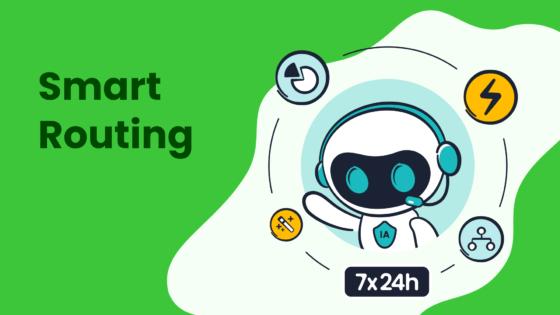
How Sobot's Voice/Call Center Enhances KPI Tracking
Sobot's Voice/Call Center solutions provide advanced tools to help you track and optimize call center KPIs effectively. These tools include real-time monitoring, intelligent IVR, and AI-powered analytics. They allow you to measure critical metrics like First Call Resolution (FCR), Average Handle Time (AHT), and Customer Satisfaction Score (CSAT) with precision. By consolidating data into a unified workspace, Sobot ensures you have a clear view of your call center's performance.
The impact of Sobot's technology is evident in its performance data. For example:
| Metric | Result |
|---|---|
| Reduction in inbound call volume | 20% |
| Customer satisfaction score | 96%+ |
| Correct answers | 80%+ |
| Customer satisfaction | 95%+ |
| Self-service question resolution | 22.2% |
| Problem resolution rate | 85% |
| Customer happiness | 99% |
| Sign-off rate | 35% increase |
| COD collection rate | 40% increase |
These results demonstrate how Sobot's solutions enhance operational efficiency and customer service quality. With a 99.99% system uptime, Sobot ensures uninterrupted access to these insights, enabling you to make data-driven decisions confidently.
Real-Life Success Stories: Samsung's 30% Efficiency Boost
Samsung's collaboration with Sobot showcases the transformative power of modern call center solutions. Facing challenges in managing high inquiry volumes across multiple channels, Samsung implemented Sobot's all-in-one contact center platform. This integration unified communication channels, improved data connectivity, and provided intelligent tools for agents.
The results were remarkable. Samsung achieved a 30% increase in agent efficiency and a 97% customer satisfaction rate. The platform's smart call routing and AI-powered analytics allowed agents to resolve issues faster, reducing Average Handle Time (AHT) and improving First Call Resolution (FCR). VIP customers also benefited from personalized video support, enhancing their experience further.
Samsung's success highlights how Sobot's solutions can transform your call center into a hub of efficiency and customer satisfaction.
Leveraging AI and Automation for Smarter KPI Management
AI and automation have revolutionized how you manage call center KPIs. AI analyzes large volumes of data to identify patterns and trends that human analysts might miss. For example, it can pinpoint agent behaviors that lead to high customer satisfaction or predict call volumes to optimize staffing.
| Insight | Description |
|---|---|
| AI Data Analysis | Identifies patterns in call center data to improve agent performance. |
| Predictive Models | Forecasts trends and customer behaviors for proactive management. |
| Proactive Customer Service | Anticipates customer needs to address issues before they arise. |
Automation complements AI by handling repetitive tasks like ticket creation and follow-ups. This reduces Average Handle Time (AHT) and improves First Call Resolution (FCR). Sobot's AI-powered Voicebot, for instance, automates routine interactions, ensuring faster resolutions without compromising quality.
By leveraging these technologies, you can transform your call center into a data-driven operation that excels in customer service and operational efficiency.
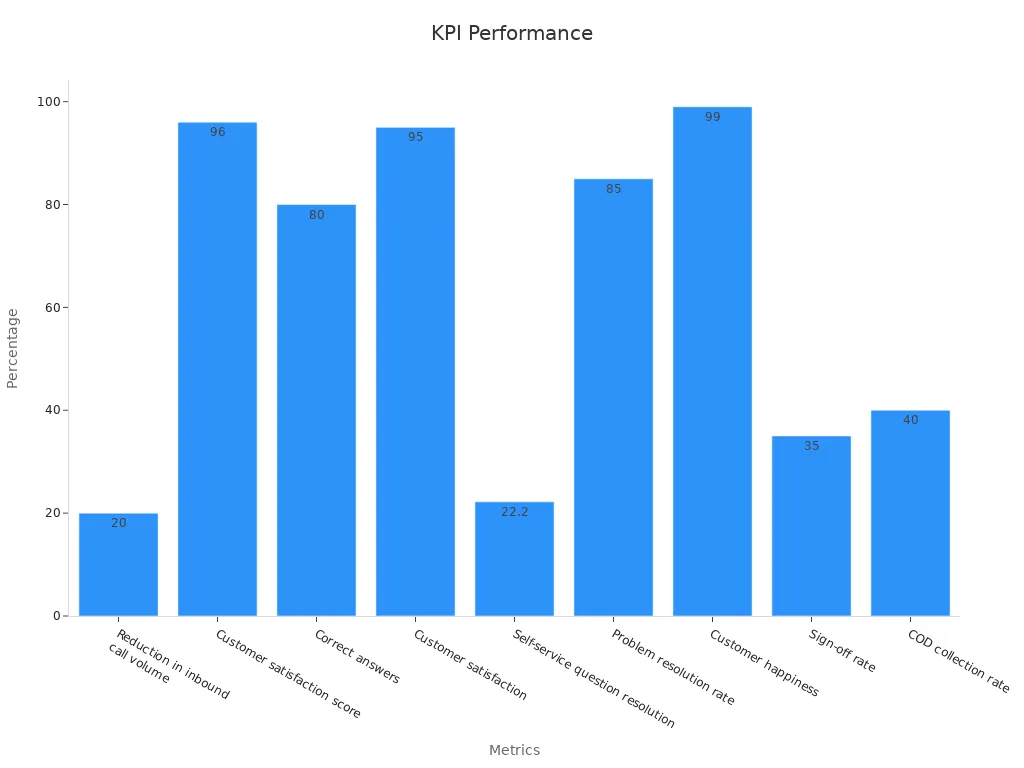
Tip: Use AI-driven insights to identify skill gaps and provide tailored coaching for agents. This approach boosts performance and ensures consistent service quality.
Ensuring Scalability and Stability with Sobot's 99.99% SLA
Scalability and stability are critical for modern call centers. As your business grows, your call center must handle increasing call volumes without compromising performance. Sobot’s Voice/Call Center solutions ensure this with a 99.99% Service Level Agreement (SLA). This high uptime guarantees uninterrupted operations, even during peak periods.
A stable system minimizes downtime, which can disrupt customer service and damage your reputation. For example, a study by Gartner revealed that downtime costs businesses an average of $5,600 per minute. With Sobot’s 99.99% SLA, you avoid such losses. The system’s global network, spanning 110 points of presence in 93 cities, ensures reliable connectivity worldwide.
Scalability is equally important. Sobot’s platform grows with your business. Whether you manage 100 calls or 10,000, the system adapts seamlessly. Features like intelligent IVR and smart call routing optimize workflows, ensuring efficient call handling. This flexibility supports businesses of all sizes, from startups to global enterprises.
Sobot also prioritizes security. The platform uses encrypted data transfer to protect sensitive information. This ensures compliance with industry regulations and builds customer trust.
Tip: Use Sobot’s real-time monitoring tools to track performance as your call center scales. These insights help you identify trends and make proactive adjustments.
By choosing Sobot, you gain a partner committed to your success. The 99.99% SLA, combined with advanced features, ensures your call center operates smoothly, no matter the demand. Learn more about Sobot’s Voice/Call Center solutions here.
Call center KPIs are essential for improving customer satisfaction, boosting agent productivity, and ensuring operational success. Metrics like Average Handle Time and First Call Resolution provide actionable insights that drive better outcomes. By adopting a data-driven approach, you can personalize customer interactions, optimize workforce management, and leverage automation to enhance efficiency. Sobot’s Voice/Call Center solutions simplify KPI tracking with tools like real-time monitoring and AI-powered analytics. These features empower you to make informed decisions and continuously improve your call center operations, transforming it into a hub of excellence.
FAQ
What are call center KPIs, and why are they important?
Call center KPIs are measurable metrics that evaluate your call center's performance. They help you track customer satisfaction, agent productivity, and operational efficiency. For example, monitoring First Call Resolution (FCR) ensures issues are resolved quickly, improving customer trust. Tools like Sobot’s Voice/Call Center simplify KPI tracking with real-time analytics.
How can Sobot’s Voice/Call Center improve my KPI tracking?
Sobot’s Voice/Call Center offers features like intelligent IVR, AI-powered analytics, and real-time monitoring. These tools help you measure critical KPIs such as Average Handle Time (AHT) and Customer Satisfaction Score (CSAT). For instance, Sobot’s unified workspace consolidates data, enabling faster decision-making and better performance insights.
Which KPIs should I prioritize for customer satisfaction?
Focus on Customer Satisfaction Score (CSAT), Net Promoter Score (NPS), and First Call Resolution (FCR). High CSAT reflects positive experiences, while NPS measures loyalty. FCR ensures issues are resolved on the first call. Sobot’s solutions provide tools to monitor these metrics effectively, enhancing customer satisfaction.
How does AI help optimize call center KPIs?
AI automates repetitive tasks, analyzes data, and predicts trends. For example, Sobot’s AI-powered Voicebot reduces Average Handle Time (AHT) by handling routine inquiries. AI also improves First Call Resolution (FCR) by routing calls to the right agents, ensuring faster and more accurate resolutions.
Can Sobot’s solutions scale with my business?
Yes, Sobot’s Voice/Call Center solutions are designed for scalability. With a 99.99% SLA and global network support, Sobot ensures uninterrupted operations as your business grows. Whether you handle 100 or 10,000 calls daily, Sobot adapts seamlessly to meet your needs.
See Also
Essential Strategies for Effective Call Center Quality Management
Comprehensive Overview of QMS Principles for Call Centers
Enhancing Call Center Efficiency Through Effective Monitoring